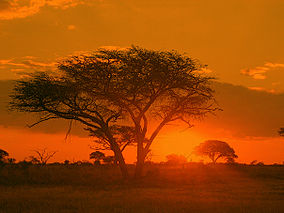| Matobo National Park | |
|---|---|
 Sunrise in Matobo National Park, 2006 | |
 | |
| Location | Matobo District, Zimbabwe |
| Nearest city | Bulawayo |
| Coordinates | 20°33′00″S 28°30′29″E / 20.55°S 28.508°E |
| Area | 424 km2 (164 sq mi) |
| Established | 1926[1] |
| Governing body | Zimbabwe Parks and Wildlife Management Authority |
| Official name | Matobo Hills |
| Type | Cultural |
| Criteria | iii, v, vi |
| Designated | 2003 (27th session) |
| Reference no. | 306 |
| Region | Africa |
The Matobo National Park forms the core of the Matobo or Matopos Hills, an area of granite kopjes and wooded valleys commencing some 35 kilometres (22 mi) south of Bulawayo, southern Zimbabwe. The hills were formed over 2 billion years ago with granite being forced to the surface; it has eroded to produce smooth "whaleback dwalas" and broken kopjes, strewn with boulders and interspersed with thickets of vegetation. Matopo/Matob was named by the Lozwi. A different tradition states that the first King, Mzilikazi Khumalo when told by the local residents that the great granite domes were called madombo he replied, possible half jest, "We will call them matobo" - an Isindebele play on 'Bald heads'.[2]
The Hills cover an area of about 3,100 km2 (1,200 sq mi), of which 424 km2 (164 sq mi) is National Park, the remainder being largely communal land and a small proportion of commercial farmland. The park extends along the Thuli, Mtshelele, Maleme and Mpopoma river valleys. Part of the national park is set aside as a 100 km2 (39 sq mi) game park, which has been stocked with game including the white rhinoceros. The highest point in the hills is the promontory named Gulati (1,549 m; 5,082 ft) just outside the north-eastern corner of the park.
Administratively, Matobo National Park incorporates the Lake Matopos Recreational Park, being the area around Hazelside, Sandy Spruit and Lake Matopos.
The national park is located within the southern Africa bushveld ecoregion.
- ^ National Parks and Nature Reserves of Zimbabwe, World Institute for Conservation and Environment Archived 2012-04-16 at the Wayback Machine.
- ^ Burrett, Robert S.; Moira FitzPatrick; Julia Duprée (2016). The Matobo Hills : Zimbabwe's sacred landscape (First ed.). Bulawayo, Zimbabwe. ISBN 978-0-7974-9808-2. OCLC 986991272.
{{cite book}}: CS1 maint: location missing publisher (link)